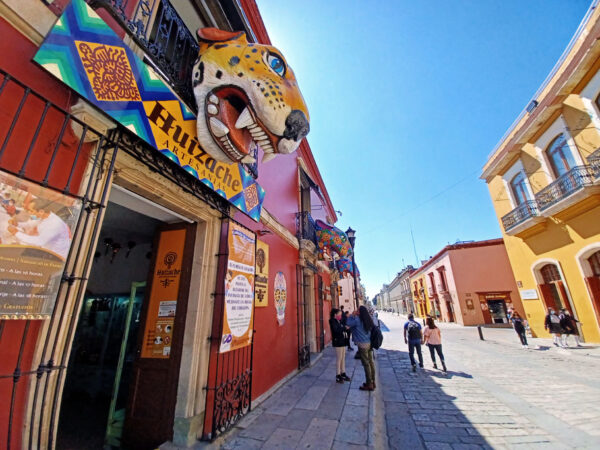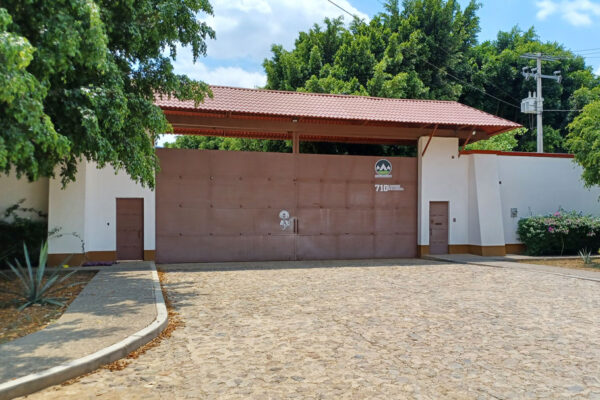
January 27 – May 23, 2023.
On our last morning in Puebla, we woke up early at our urban camping spot on the street in front of the tourist police building. As we pulled away and drove through the downtown streets, we saw bags of trash still lining the sidewalks waiting to be picked up. The city was yet to fully wake up. We swung by our friends’ Airbnb, loaded them and their luggage into Ballena Blanca, and hit the road toward the city of Oaxaca in a state also called Oaxaca.
Oaxaca, pronounced “wah-HAH-kah”, is between 210 and 250 miles south of Puebla depending on your route. The longer, but free route would have taken us around 7 hours without stops, 3 hours more than the shorter route with tolls. We normally avoid the toll roads, not only to save money but also to experience the off-the-beaten-path small towns of Mexico. But we needed to get our friends to their next Airbnb so we decided to do the shorter, less interesting ride and pay the tolls.
We dropped our friends off in El Centro Oaxaca where they were greeted warmly by their Airbnb hosts and offered a shot of mezcal. We would soon come to learn that sharing mezcal and other drinks is something that Oaxaqueños love to do.
After leaving our friends at their Airbnb, Greg and I drove another 6.5 miles to a campground called El Rancho RV Park in the small town of Santa Maria del Tule. The plan was to stay at the RV Park for a couple of weeks and take buses or colectivos into town to hang out with our friends and to use Ballena Blanca to pick up our friends for excursions out of town. It didn’t quite work out like that.

Our van broke down and we ended up staying at the RV Park for 4 months. If you are just tuning in, check these links – February, March, April, May – to read the whole saga of our trials and tribulations of trying to get Ballena Blanca repaired.
In the end, we decided that we were rather lucky. We could have broken down in a whole lot worse locations. The campground was the perfect spot to be stranded and Oaxaca is probably one of my favorite places in Méxcio. We had previously visited the city and some of the sites around it on our trip to México four years ago and since then I had been waiting to return and see everything we had missed. We didn’t get to every place I had hoped to but this time we got to experience a whole lot more of the city, as well as more archeological sites in the region, a few nearby pueblos, and the magic of mezcal.
Today I’m going to start with our experiences in the city. Declared a UNESCO World Heritage site in 1987 along with the nearby archeological site of Monte Alban, the city is officially called Oaxaca de Juárez. The “de Juárez” was added to the city’s name in 1872 to honor Oaxaca native, Benito Juárez, who became México’s first indigenous president in 1858.
Compared to the city we had just come from, Puebla (also a World Heritage Site), Oaxaca seemed far more touristy. Still despite the flow of gringos and other tourists wandering along the picturesque cobblestone streets lined with historic colonial buildings, the city felt quieter, less busy, more open, bright, and relaxed.
On our first day, we took a free (tip-based) Oaxaca by Locals walking tour. This was our first time taking one of these types of free tours and I now highly recommend them. It was a great way to not only get orientated with the city and see the sights but learn a few things about the city that you won’t read about in tourist brochures like areas to be alert in and political controversies.
Las Calendas
Of all the things we learned about on the walking tour, I think the best thing our tour guide told us was about the Saturday Calendas.
Almost every Saturday (and sometimes other days) parades dance their way down the street in front of the Cultural Museum. These calendas celebrate weddings, quinceaneras, birthdays, and other noteworthy occasions. They all include monos, large puppets with swinging arms, a marmota, a large spinning globe with the names of the people or occasion being celebrated, dancers dressed in indigenous and traditional garb, and a brass band. And possibly some mezcal.
We caught 3 calendas on a Saturday and a surprise one on a Friday.
Of course, these still images just give you a small idea of what it is like to actually be there. So here are a few short videos to bring the pictures to life.
Parks and Plazas
The calendas dancing down the street in front of the Cultural Museum aren’t the only way to see the liveliness and color of Oaxaca. The Zocálo is a popular hangout with roving live entertainment and merchants selling colorful balloons, jewelry, snacks, and more. In this plaza, you might catch a recital by schoolchildren or performances by visiting entertainers.
Another public space we enjoyed was El Llano. This park, located a ways from the city center is less touristy. Here you can get street food, join a dance class, or take your children to the blowup slide on the weekend.
We wandered over to the west side of town one day and found Jardín Sócrates, a super cute plaza with colorful restaurants adjacent to the Basílica de Nuestra Señora de la Soledad.
Barrio de Jalatlaco & Murals
Oaxaca like so many Mexican cities is covered with murals. Probably the biggest concentration can be found in the Barrio de Jalatlaco, a neighborhood on the east side of the city.
Museums
And, of course, there are museums. The Museo de las Culturas is a definite must-see. The admission fee was 90 pesos – about $5. Much of this INAH (National Institute of Archeology and History) museum focuses on archaeological finds, including artifacts from Tomb 7, one of the richest archaeological finds of pre-Columbian Mesoamerica. The museum also has great temporary displays. On our visit, we saw a display of Xolos, the Mexican hairless dogs, and art inspired by children’s books. And like most Mexican museums we have visited, the building, an old 16th/17th-century convent, was as interesting as any of the displays.
We also visited three free more museums in Oaxaca, Museo Textil de Oaxaca (Textile Museum), Ex Convento de San Pablo (Art and artifacts in an old convent), and Museo De La Filatelia (Stamp museum). The Stamp Museum was my favorite.
Día de la Samaritana
Lots of holidays are celebrated in Mexico but sometimes a city or region will have its own special holiday that is only celebrated in that city or region. Oaxaca’s is Día de la Smaritana. This holiday commemorates the biblical story where Jesus meets a Samaritan at a well. It is celebrated by businesses and individuals inviting people into their homes and establishments, and setting up stands along the streets offering free water to anyone who asks. But this water, called aguas frescas, like many things one might consume in Mexico, is vastly improved upon from anything we gringos might call water. Some Aguas Frescas are just flavored waters like Jamaica, a hibiscus flower tea, but some contain actual food like Agua de Chilacayota, a pumpkin-flavored water with a whole lot of pulp. There is horchata made from water, rice, cinnamon, sugar, and vanilla, and Tejate made of ground corn, ground cacao, mamey seed, rosita de cacao, and optional sugar. Popsicles are also considered water.
We were lucky to be taking Spanish lessons on the Friday of the holiday. Our Spanish teacher, Friida told us to bring cups that day and after enjoying some agua frescas at school Friida accompanied us around El Centro to enjoy even more. Luckily we started early because soon after the event started lines became long. Back at the campground that afternoon we found more free water offered by the campground owners and heard stories of some campers who were riding in a colectivo and were brought free water at a traffic light. The Oaxaqueños absolutely adore this holiday.
Protest
It’s not a party all the time in Oaxaca. The city is also very political. Political posters abound. And protesters sometimes block the streets. Students, the indigenous community, and teachers voice their concerns and demands in public spaces. On our last day in the city educators from around the region turned the zocálo into a tent city.
So now you know a few of the reasons why we were lucky to be stranded in Oaxaca. Next time we will discover ancient history for more reasons Oaxaca is the best place to have your van break down.
* All pics are click to enlarge. Once you have them enlarged you can view them in a slide show.
* We always love to hear your comments. Did you enjoy this post? Did it inspire you to think about anything – places you’ve been, events you’ve attended? Have you been to Oaxaca? Are you ready to visit Oaxaca?







































































Always love reading your posts as they convey so much information, so many fabulous photos, and a true sense of what you’ve been doing.i like your sense of adventure and acceptance or aplomb when something goes away.
Thanks, Annie! I need to get caught up on your blog. Sometimes little (or big) setbacks happen with travel. Gotta get back up and keep moving!
Your posts are a pleasure to read. It’s almost being there with you and experiencing it. Also, the photography is exceptional. What camera are you using?
Thank you, Heinz!
Mostly I use my phone camera. It has a great wide angle feature. It’s a Galaxy A32 5G. I’m kind of a lazy photographer. For anything telephoto, I use a Sony Cyber-shot RX10 iv. So, in this post, the Balloon seller and the Ecuadorian flute player would have been shot with the Sony. Ultimately my photos look the way they do because of the method I use to “process” them that sharpens them and brings out details.
I’m glad you enjoy the blog. I have read a little about your PanAm journey on Find Penguins. What a great trip!
Love the color in Mexican towns and cities!
Thanks for bringing your travels to us.
You are so welcome John!
Well, it’s no surprise you – and so many others – love Oaxaca. I agree that it was a pretty good place to break down and spend a few months. While not quite what you had in mind, when “waiting to return and see everything you had missed”, you sure had plenty of opportunities to explore this time around!
I’d never heard of those calendas. They sound and look really interesting. And, who would not enjoy those zocalos and murals? Man, you make me want to go live in Oaxaca for a few months!
It is a festive place. There is so much to love about this area of Mexico (more posts to come).
Greg says we are never returning, but there is still lots I’d like to explore in the area. You could spend months not only enjoying Oaxaca but making day trips from the city.
It’s was such a disappointment that we didn’t get to move on, but honestly, we would have missed a lot in Oaxaca.